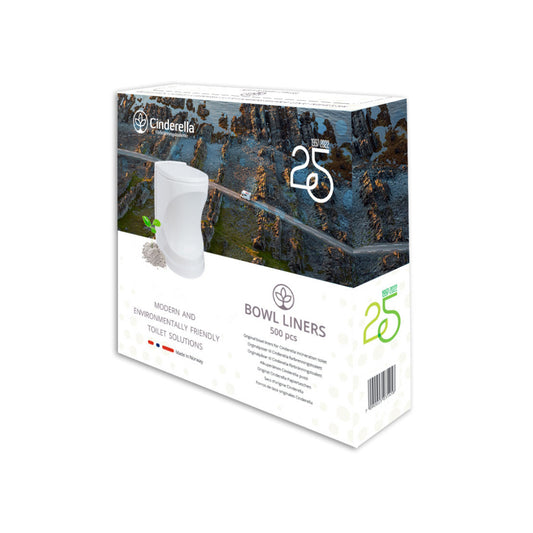Essential for optimal toilet function. Discover the design, materials, and production of our new bowl liners.
Cinderella incineration toilets offer a unique solution for waste management. A key component of these toilets is the bowl liner, which plays a crucial role in the efficient transportation of waste to the incineration chamber. In this article, we'll delve into the production process, materials used, and the sustainable aspects of Cinderella bowl liners.
Production process
The production of Cinderella bowl liners takes place at our state-of-the-art facility in Lyngen, Norway. An automated process involves bonding multiple layers of paper together and cutting the bowl liner to the desired size. Advanced machinery ensures precision and efficiency throughout the production process.

Behind the scenes: The machine that produces Cinderella's bowl liners.
What type of paper is used in the bowl liners?
The choice of paper is crucial for both functionality and the environment. Our bowl liners are made from unbleached, brown kraft paper, which we receive in large rolls from Mondi Group in Sweden. Mondi is a global leader in packaging and paper production, with factories in more than 30 countries.

Large rolls of unbleached kraft paper, sourced from Sweden, are the key ingredient in our bowl liners.
Mondi Group is a member of both FSC, which ensures sustainable forest management, and PEFC, the world’s largest certification system for sustainable forestry. We choose to work with suppliers who meet high standards for quality and sustainability, contributing to the reliability and responsibility of our products.
We have transitioned to using unbleached paper for our liners. By switching to unbleached paper, we have eliminated the use of harmful chemicals such as chlorine and bleach in the production process.
Do the bowl liners contain plastic?
To ensure optimal functionality and prevent moisture leakage, our bowl liners incorporate a thin plastic film on the inside.
This film is made from LDPE (low-density polyethylene) and amounts to only 10 grams per square meter of paper. LDPE is a thermoplastic that melts at 110-115 degrees Celsius. During the incineration process, where the temperature reaches 500-600 degrees, the plastic film melts completely, leaving no solid residue behind.
Although we use plastic to ensure the liner's functionality, we are conscious of our environmental responsibility. That’s why we collaborate with certified suppliers and continuously evaluate the materials we use to ensure that our products meet both functional and environmental standards.

See how our bowl liners are built: A sturdy foundation of brown kraft paper, protected by a waterproof LDPE coating.
How does Cinderella work with sustainability and the environment?
We are actively working to evaluate and improve our material choices and production processes to reduce environmental impact. By collaborating with suppliers who adhere to strict EU regulations for responsible production, our goal is to always find solutions that balance functionality with environmental considerations.

Our high-quality bowl liners are carefully packaged in sturdy boxes, ready for shipment.
Sources:
- Mondi Group is a leading packaging and paper supplier with a strong focus on sustainable solutions. (Read more about their certifications here: Mondi Group sustainability certificates)
- Learn more about FSC: FSC certification
- Learn more about PEFC: PEFC certification







